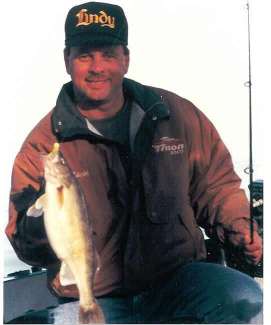





















Free 90 day Risk free trial offer click
here

|
Gettin’ Jiggy with it
By John Kolinski
EDITOR’S NOTE: John Kolinski is an eight-time championship qualifier
during
his seven years of professional fishing on the Professional Walleye
Trail and
the Masters Walleye Circuit.
Any angler worth his lead counts jig-fishing among the top tactics in
his or
her walleye fishing arsenal. Few methods provide more versatility in
presentation. Jigs can be cast, flipped, pitched, bounced, twitched, dragged
and even trolled. They can be lightweight, heavyweight, bulky, streamlined
and even baited. It’s a time-tested way to catch springtime walleyes when
water temperatures are still in the 40s and 50s, and the fish are ganged
up in predictable locations. Whether it’s a prespawn situation or a postspawn
condition, jigs offer an angler the ultimate in finesse and control.
There’s also something special about taking an object as innate as
a piece of
lead with a hook in it, and bringing it to life in your own special
way. It’s
as interactive as fishing gets, and few sensations in the sport can
compare
to the excitement of a “tunk-tunk-tunk” followed by a solid hookset.
At the same time, spring walleyes can be a stubborn lot. Constantly
shifting
weather patterns, along with sudden changes in water quality, clarity,
depth
and flow, all come into play. The same fish that were whacking a jig
with
abandon one day can develop a severe case of lockjaw the next.
On the tournament trail, those who find ways to deal with these extreme
situations take home the paychecks. Desperate times, as the saying
goes, call
for desperate measures.
 Sometimes, success means modifying traditional presentation methods to
deal with the situation at hand, or even creating new ways to coax neutral
or negative walleyes to bite. If there’s one constant in the angler’s favor,
it’s a walleye’s need to eat. Even when water temps are cold and walleyes
seem a little sluggish, they still need to eat as they build reserves for
the rigors of the spawning ritual or attempt to regain their strength afterward.
It’s not in a walleye’s nature to work any harder for its dinner than absolutely
necessary. That knowledge helps us reduce the plethora of potential places
a walleye might hide to a handful that offer plenty of forage and ambush
locations. It’s one of those times when presentation becomes at least as
important as location.
Sometimes, success means modifying traditional presentation methods to
deal with the situation at hand, or even creating new ways to coax neutral
or negative walleyes to bite. If there’s one constant in the angler’s favor,
it’s a walleye’s need to eat. Even when water temps are cold and walleyes
seem a little sluggish, they still need to eat as they build reserves for
the rigors of the spawning ritual or attempt to regain their strength afterward.
It’s not in a walleye’s nature to work any harder for its dinner than absolutely
necessary. That knowledge helps us reduce the plethora of potential places
a walleye might hide to a handful that offer plenty of forage and ambush
locations. It’s one of those times when presentation becomes at least as
important as location.
The term jigging implies an action imparted by the angler. Sometimes,
that’s
as simple as bouncing jigs vertically along current breaks or proven
structure while drifting with the current or the wind. Sometimes, it’s
not. For those situations, I fall back on three offbeat approaches that
have helped me cope with some of these unusual situations. These methods
are most effective when dealing with the adverse conditions that come with
spring, but they can also be deadly later on in the season when other factors
put walleyes in a neutral or negative mood.
Wiggle-jigging is a technique tournament buddies Doug Newhoff
and Neil
Hammargren of Iowa came upon while trying to coax some reluctant walleyes
to bite on the Mississippi River. We’d found the fish along a small gravel
bar
in the current the previous couple of days, but the action was slow,
at best,
using traditional jigging approaches. While Newhoff was tying a new
jig on one rod, he put the other in a rod holder so the minnow-tipped,
quarter-ounce  Lindy
Fuzzy Grub was suspended just a few inches off the bottom. He didn’t
even get the new jig tied on when the rod tip jumped once, then loaded
up with the weight of a fish that turned out to be a 3-pound walleye. Lindy
Fuzzy Grub was suspended just a few inches off the bottom. He didn’t
even get the new jig tied on when the rod tip jumped once, then loaded
up with the weight of a fish that turned out to be a 3-pound walleye.
When Newhoff resumed fishing with both rods, he took the same approach,
letting his jigs find the bottom, reeling them up a couple of inches
and
holding them steady with no more than an occasional wiggle. After he
put his
third fish in the boat in a matter of 30 minutes, Hammargren asked
what he
was doing. “Nothing,” Newhoff replied. “And I mean nothing.” In a couple
of hours those two had a five-fish limit in the 15-pound range that few
other anglers could match. It has worked for me, as well, and since then,
it’s one of the first directions I turn when traditional jigging methods
aren’t getting it done.
Dragging jigs goes against all the basic principles of jigging, but
it works.
I’ve heard dozens of stories from anglers whose spouses or children
have
tired of bouncing jigs. While the old pro diligently works two jigging
sticks
from the front of the boat, their guests for the day simply put their
rods
down or let their jigs drag along with no action. The next thing you
know,
they’ve got a fish on. It’s a technique I’ve used with success in dirty-water
situations. A thunderstorm, for example, doesn’t always drive fish to the
deepest water they can find, but it will likely drive them belly to the
bottom. They won’t feed actively and they won’t chase lures like crankbaits
or bouncing jigs., A jig churning up the bottom in front of their faces,
however, looks too much like an easy meal for them to pass up. For years,
a favorite early season presentation on the tournament scene consists of
a three-way rig with a jointed or floating  in the F9-F13
in the F9-F13
size range. In states where two hooks on a line are legal, try a Lindy
Jumbo
Jig tipped with a minnow as a dropper rather than a standard sinker.
It’s a proven combination, and I’ve caught as many walleyes on the Jumbo
Jig
dropper over the years as I have on the Rapala. Perhaps the most extreme
adaptation I’ve had to make over the years is feeding jigs. Many anglers
insist that short strikes and light bites come from small fish that lack
the strength to inhale a jig like the larger members of their family. Experience
tells me that’s not always true. Active walleyes eat by opening their mouths
and creating a vaccuum of moving water that sucks their prey into their
mouths. It’s logical to assume that when a jig and minnow combination comes
back to the boat or to shore with the\ skin stripped off the minnow, that
simply means the angler, the wind or the current was moving the jig too
fast for the fish to engulf it.
That may not be the case. Trial and error have taught me that there
are times
when you absolutely have to let a walleye take a jig like you let a
catfish
take a nightcrawler. Otherwise, you’ll be just another frustrated,
and
fishless, angler.
We’ve all seen it happen. We’re casting jigs or fishing them vertically
when
we feel the slightest resistance or weight on the end of the line.
You set
the hook and there is nothing there, and when you retrieve the jig,
the
minnow is either mangled or missing. The next time this happens to
you, try holding the rod tip in place for a couple of seconds. If you feel
a second “thump,” set the hook. Usually, you’ll be in business, but not
always. Sometimes, you have to wait even longer. The walleye has the minnow
clamped between its teeth, but for whatever reason it wants to take it
to deeper water before eating it. So, let it go. Often, you can get a good
hookset while the fish is swimming directly away from you. Other times,
it’s more effective to wait until the fish stops swimming. Then, you will
usually feel that second “thump” that
tells you the walleye has finished what it started. Hopefully, most
of your jigging days include aggressive walleyes that liketheir jigs presented
in traditional manners. If not, be quick to trysomething different.
And sometimes, aggressive jigging will take the active fish from an
area, but
the bite will suddenly die. That doesn’t mean the walleyes have left.
Let the
walleyes tell you what they want.
Pop your jigs aggressively. Try lifting them and lowering them slowly.
Drag
‘em, wiggle ‘em or feed ‘em. Mix it up until you’ve tried a little
of
everything, and chances are you’ll come across a presentation that
works.

Walleyes Inc. web site is maintained
by Randy
Tyler Fishing the In-Fisherman Professional Walleye Circuit, Masters
Walleye Circuit, RCL and the Team Walleye Circuit. All rights reserved.
Copyright 1999/2001
Please visit these site sponsors
Daiichi/Tru-Turn Hooks,
Lindy
Little Joe,
R-A.M Mounting Systems,
Ranger
boats, Mercury Marine, Bedford
Sales , Hamby's Beaching Bumpers,
Goldeneye
Marine products, Panther
Marine Products, Webfoots body
sock, Bait Rigs Tackle
|



 Sometimes, success means modifying traditional presentation methods to
deal with the situation at hand, or even creating new ways to coax neutral
or negative walleyes to bite. If there’s one constant in the angler’s favor,
it’s a walleye’s need to eat. Even when water temps are cold and walleyes
seem a little sluggish, they still need to eat as they build reserves for
the rigors of the spawning ritual or attempt to regain their strength afterward.
It’s not in a walleye’s nature to work any harder for its dinner than absolutely
necessary. That knowledge helps us reduce the plethora of potential places
a walleye might hide to a handful that offer plenty of forage and ambush
locations. It’s one of those times when presentation becomes at least as
important as location.
Sometimes, success means modifying traditional presentation methods to
deal with the situation at hand, or even creating new ways to coax neutral
or negative walleyes to bite. If there’s one constant in the angler’s favor,
it’s a walleye’s need to eat. Even when water temps are cold and walleyes
seem a little sluggish, they still need to eat as they build reserves for
the rigors of the spawning ritual or attempt to regain their strength afterward.
It’s not in a walleye’s nature to work any harder for its dinner than absolutely
necessary. That knowledge helps us reduce the plethora of potential places
a walleye might hide to a handful that offer plenty of forage and ambush
locations. It’s one of those times when presentation becomes at least as
important as location.